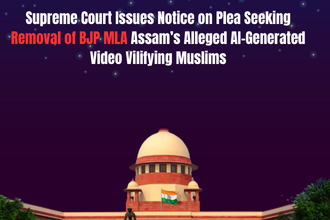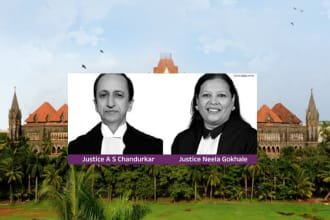New Delhi, October 8, 2025: The Supreme Court of India on Tuesday issued notices to social media platform X (formerly Twitter), the Assam Government, and the Union Government of India in connection with a plea seeking the removal of an allegedly AI-generated video shared by the BJP Assam unit, which purportedly vilifies the Muslim community and threatens communal harmony in the State.
The bench, comprising Justice Vikram Nath and Justice Sandeep Mehta, was hearing an application filed in the ongoing Public Interest Litigation (PIL) — Qurban Ali vs. Union of India & Ors — which seeks judicial action against the proliferation of hate speech and hate crimes across India. The Court has listed the matter for further consideration on October 28, 2025.
Background of the Case
The PIL was originally filed by journalist Qurban Ali and Senior Advocate Anjana Prakash, urging the Supreme Court to intervene against rising incidents of hate speech and communal propaganda in the country. Earlier, in this very PIL, the apex court had directed all States and Union Territories to suo motu register FIRs against individuals delivering hate speeches, without waiting for formal complaints.
In the present application, the petitioners have brought to the Court’s attention a controversial video posted by the official BJP Assam account on X. The video allegedly depicts a “Muslim takeover” of the state in the event the ruling party loses the upcoming polls.
According to the plea, the video portrays individuals wearing skull caps and burqas seizing control of major public spaces and landmarks such as tea estates, Guwahati Airport, Rang Ghar, and the Guwahati Stadium. It also purportedly suggests that illegal migration from Bangladesh and encroachment on government land by Muslims would lead to a future scenario where the state’s population becomes “90% Muslim.”
Viral Impact and Concerns Over Communal Disharmony
The petitioners emphasized the massive reach and virality of the video, underlining its potential to incite religious hatred and public disorder.
“As on 18.09.2025 (17:48 Hrs), the video has been reposted 6,100 times, liked over 19,000 times, and viewed approximately 4.6 million times. Thus, it is required to be taken down immediately to contain any further spread of communal disharmony, unrest, and enmity,” the plea stated.
The plea argues that the circulation of such content by a political party’s official social media account constitutes a serious breach of constitutional principles, particularly the secular fabric enshrined in the Preamble and Articles 14, 15, and 25 of the Constitution of India.
The petitioners contended that such divisive propaganda, when spread by the ruling party, represents a “gross dereliction of constitutional duty” and undermines the values of equality, unity, and fraternity that form the foundation of Indian democracy.
Arguments Presented Before the Court
Advocates Nizam Pasha, Lzafeer Ahmad, and Rashmi Singh appeared for the applicants. They argued that the State government, being constitutionally bound to uphold secularism, bears a “heightened responsibility” to ensure that no content promoting religious bias or hatred is propagated — especially by an official account of the ruling political party.
The counsel submitted that even private citizens are prohibited under Indian law from sharing or publishing any speech or visual material that could incite communal enmity, citing relevant provisions from the Indian Penal Code (Sections 153A, 295A, and 505(2)) and the Information Technology Act.
Hence, the dissemination of such AI-generated propaganda by a party in power, they argued, warrants urgent judicial intervention to prevent further social unrest and erosion of communal harmony.
The petitioners also urged the Court to issue directions for immediate removal of the video from all digital platforms and to initiate criminal proceedings against those responsible for creating and disseminating the content.
AI-Generated Disinformation: A Growing Legal Challenge
The case has reignited discussions on the ethical and legal implications of AI-generated media in political communication. The use of deepfake or AI-generated visuals to spread misinformation or communal narratives poses a serious challenge to free and fair elections, data integrity, and constitutional governance.
Digital experts warn that AI-generated political content can manipulate public perception, polarize voters, and undermine trust in democratic institutions. In this case, the video allegedly used AI tools to fabricate visuals implying religious dominance — a trend that, if unchecked, could have far-reaching social and political consequences.
Legal analysts point out that India currently lacks a comprehensive regulatory framework specifically addressing AI-generated misinformation, though the Information Technology (Intermediary Guidelines and Digital Media Ethics Code) Rules, 2021 provide some scope for content moderation and accountability of intermediaries like X.
Supreme Court’s Prior Interventions on Hate Speech
This plea falls within the Supreme Court’s broader efforts to curb hate speech and safeguard constitutional morality. In previous hearings related to the same PIL, the apex court had underscored that “inaction by authorities on hate speech is itself a form of complicity.”
The Court emphasized that police authorities must take suo motu action against hate speeches, irrespective of the religion or political affiliation of the speaker. It further observed that “freedom of speech cannot be used as a weapon to promote disharmony or division” in a diverse and secular nation like India.
Political and Legal Implications
The present case could have significant political ramifications, particularly in Assam — a state that has historically witnessed religious and ethnic tensions over issues of migration and identity.
If the Supreme Court orders the removal of the BJP Assam video, it may set a precedent for stricter judicial scrutiny over political content on social media, especially that which employs AI or deepfake technology. It could also reaffirm the principle that political speech, while protected, is not immune from constitutional limitations when it threatens public order or religious harmony.
Next Hearing and Way Forward
The Supreme Court bench has directed the Centre, Assam Government, and X to respond to the petition. The matter is slated for further hearing on October 28, 2025.
Observers note that this case could shape India’s evolving legal stance on AI-generated misinformation, hate speech regulation, and accountability of political actors in the digital age.
As debates over free expression, technology, and secularism intensify, the Supreme Court’s eventual decision may well determine the balance between political communication and constitutional morality in India’s democracy.



